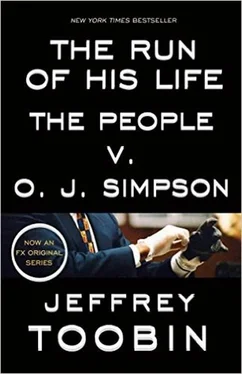In the courtroom that day, the first few examples from the tapes were fairly straightforward-brief sentence fragments of Fuhrman’s familiar voice: “You do what you’re told, understand, nigger?” Female officers, he said, “don’t do anything. They don’t go out there and initiate a contact with a six-foot-five nigger that’s been in prison for seven years pumping weights.” And: “These niggers, they run like rabbits.” Of course, these snippets were bad enough, but then, late in the morning session, Uelman began to play the tape of what appeared to be Fuhrman’s recounting of an incident that had happened to him in the field. It was, according to Fuhrman on the tape, “a real heavy investigation… sixty-six allegations of brutality… assault and battery under color of authority. Torture, all kinds of stuff.” Then Fuhrman’s disembodied voice described for the silent courtroom what had happened.
Two of my buddies were shot and ambushed, policemen. Both alive, and I was the first unit on the scene. Four suspects ran into a second story in an apartment project-apartment. We kicked the door down. We grabbed a girl that lived there, one of their girlfriends. Grabbed her by the hair and stuck a gun to her head and used her as a barricade. Walked up and told them: “I’ve got this girl; I’ll blow her fucking brains out if you come out with a gun.” Held her like this-threw the bitch down the stairs-deadbolted the door. “Let’s play, boys.”
On the tape, McKinny interrupted to ask whether she could use this incident in the movie.
“It hasn’t been seven years, statute of limitations,” Fuhrman cautioned. “I have 300 and something pages of Internal Affairs investigation just on that one incident. I got several other ones. I must have about 3,000 or 4,000 pages Internal Affairs investigations out there.” Then Fuhrman resumed his narration of the event.
Anyway, we basically tortured them. There was four policemen, four guys. We broke ’em. Numerous bones in each one of them. Their faces were just mush. They had pictures on the walls, there was blood all the way to the ceiling with finger marks like they were trying to crawl out of the room. They showed us pictures of the room. It was unbelievable, there was blood everywhere. All the walls, all the furniture, all the floor. It was just everywhere. These guys, they had to shave so much hair off, one guy they shaved it all off. Like seventy stitches in his head. You know, knees cracked, oh, it was just-We had ’em begging that they’d never be gang members again, begging us. So with sixty-six allegations, I had a demonstration in front of Hollenbeck station, chanting my name. Captain had to take them all into roll call, and that’s where the Internal Affairs investigation started. It lasted eighteen months. I was on a photo lineup, suspect lineup. I was picked out by twelve people. So I was pretty proud of that. I was the last one interviewed. The prime suspect is always the last one interviewed. They didn’t get any of our unit-thirty-eight guys-they didn’t get one day [of docked pay]. I didn’t get one day. The custodian, the jailer of the sheriff’s department, got five days, since he beat one of the guys at the very end…
Immediately after we beat those guys, we went downstairs to the garden hose in the back of the place. We washed our hands. We had blood all over our legs, everything. With a dark blue uniform, you know, and in the dark, you can’t see it. But when you get in the light and it looks like somebody took red paint and painted it all over you. We had to clean our badges off with water; there was blood all over ’em. Our faces had blood on them. We had to clean all that. We checked each other, then we went out, we were directing traffic. And the chiefs and everything were coming down because two officers were shot-“Where are the suspects?”… And they took them to the station. Somehow nobody knows who arrested them. We handcuffed them and threw them down two flights of stairs, you know. That’s how they came. That’s where a lot of people saw, you know, “Look out! Here comes one! Oh my God, look out, he’s falling!” I mean, you don’t shoot a policeman. That’s all there is to it…
When this taped excerpt ended, Lance Ito’s courtroom was as quiet as it had ever been over the previous year. Then there was a sound: Kim Goldman started to cry.
At last Gerry Uelman asked McKinny, “Do you have a particularly vivid memory of that account?”
“Of course,” she said.
“Why is that?”
“It’s, um, it’s vividly described.”
Judge Ito broke for lunch.

Cochran’s colleagues had never seen him behave the way he did when Lance Ito’s ten-page ruling slipped out of the fax machine on August 31. Cochran was distraught, speechless, despairing. In what seemed to be a shocking blow to the defense, Ito ruled that he would allow only two brief excerpts of the Fuhrman tapes to be played: “We have no niggers where I grew up,” and “That’s where niggers live.” In lieu of playing the tapes, he would allow McKinny to tell the jury that Fuhrman had said “nigger” forty-one times on the tapes. Ito found that everything else on the tapes was either irrelevant to the Simpson case or unduly prejudicial to the prosecution.
Cochran proceeded to an impromptu news conference on the ground floor of his office building on Wilshire Boulevard. Wearing an electric-blue sports jacket over a black shirt buttoned at the neck with a jeweled clasp, Cochran denounced Ito in a most personal way. Surrounded by nearly a dozen colleagues on the defense team (but not Shapiro), Cochran called Ito’s ruling “perhaps one of the cruelest, unfairest decisions ever rendered in a criminal court.” He declared, “The cover-up continues… This inexplicable, indefensible ruling lends credence to all those who say the criminal justice system is corrupt.” And in a lightly veiled reference to Bakewell’s incendiary threats of earlier in the week, Cochran said, “So all of the citizens in Los Angeles, they should remain calm.”
Having stung Cochran in print, Ito still could not stand up to him in person. The next day in court, Friday, September 1, Cochran essentially went on strike. The defense was supposed to continue to call witnesses, but Cochran simply refused to continue the trial, in protest against the judge’s ruling on the tapes. A tougher judge might simply have declared the defense case concluded and moved on to the prosecution rebuttal. But Cochran intimidated Ito too much for that. The judge simply and meekly informed the jury, which had heard scarcely any evidence in a week because of the tapes controversy, that the trial was breaking early for Labor Day weekend.
By this point, Fuhrman had retained a criminal defense lawyer, who wisely advised him to take the Fifth Amendment rather than answer any more questions in the case. The tapes had raised a real possibility that he might be prosecuted for perjury-or even for the crimes he had told McKinny he committed. When Fuhrman returned to the courthouse to take the witness stand once again, he answered each of Uelman’s queries with invocations of his right to remain silent. (As was customary, Ito did not allow the jury to see Fuhrman take the Fifth.) Darden and his student clerks, the only African-Americans on the prosecution team, were not present when Fuhrman returned to appear before Judge Ito.
At long last, on September 6, the jury heard McKinny and the two short excerpts from the tapes. Ironically, the highlight of the day for the defense was not the playing of the tapes-which the jurors absorbed impassively-but rather Darden’s inept cross-examination of McKinny. Darden belittled McKinny’s credentials, questioned her motives, and generally treated her as if it were she-and not prosecution witness Fuhrman-who had done something wrong. Stung by Darden’s hostility, McKinny blurted out at one point, “Why are we having this adversarial relationship?” Several jurors nodded, apparently wondering the same thing.
Читать дальше













